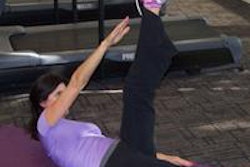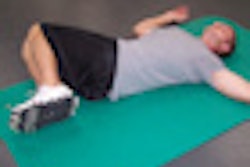AuntMinnie.com presents the first in a four-part series on overcoming work-related musculoskeletal issues for sonographers by Doug Wuebben, a cardiac sonographer, along with Mark Roozen, strength coach for the National Football League's (NFL) Cleveland Browns, and Joel Raether, strength coach for the National Lacrosse League's (NLL) Colorado Mammoth.
I love my job. I am registered in adult and pediatric echocardiography and have been doing echo for 12 years now. At about the three- to four-year mark, however, I was scanning while in so much shoulder pain everyday that I wondered how I was going to make it through the next study. But I'm not the only sonographer who's worked in pain.
A survey conducted by the Society of Diagnostic Medical Sonography (SDMS) and the Healthcare Benefit Trust (HBT) revealed that 84% of the sonographers who responded were scanning while in pain that they attributed to their work activities.1 Twenty percent of those sonographers had an injury severe enough to end their careers.
Muscles and tendons are designed to be used regularly. However, when the workload is too frequent or for too long a duration, the muscles and tendons can no longer adapt. They become inflamed, then degenerate; small microtears can occur and scar tissue forms.
Once a tendon is injured, the muscle to which it is attached must compensate by working harder to support the extremity and joint. Greater demands on the muscle result in fatigue and strain. This type of stress is a function of work pace, lack of recovery time, the high level of muscular effort, and the amount of transducer time a sonographer puts in, particularly when performing the same type of examinations repeatedly.
Muscles cannot function properly without an adequate oxygen supply. Oxygen is pumped into muscles, and waste materials are removed through the normal contraction of muscles during dynamic movement. Static postures prevent this process, resulting in less oxygen to the muscles and a buildup of lactic acid, followed by fatigue and potential injury.2 The best treatment for work-related musculoskeletal disorders is prevention.3
But if it's past the point of prevention, I can tell you from experience it's still possible to overcome severe joint and pain issues and again perform scanning without pain. This four-part series will share an approach for fixing the damage that's already been done, and I'm confident it will work for a large segment of the sonographer population that utilizes it.
Simple to understand, hard to do
My enjoyment of pain-free scanning follows an easy concept, but a difficult-to-practice philosophy. My big secret is that I started to exercise. I not only exercised, but I exercised doing the right things the right way.
I didn't just target the problem areas, or work muscles; I trained movement, which meant that I also worked out the rest of my body. I was lucky because I was able to consult with a dear friend and colleague, Mark Roozen. Mark is currently a strength coach for the Cleveland Browns of the NFL.
Mark has worked with a variety of elite athletes, as well as folks in the general population. After explaining my situation to him and informing him that I was willing to do whatever it took to curtail my pain, Mark not only gave me the ability to keep on doing what I was great at and loved doing, he also allowed me to stay in my career.
He developed an exercise program that was easy to follow but also gave me wholeness and wellness for the rest of my body. The result was so successful that I am literally pain-free when scanning.
Mark took an in-depth look at my industry and evaluated my movement strengths and weaknesses. He was able to explain that part of the pain in my shoulders was related to the underdeveloped small muscle groups comprising my shoulder area and upper back. As I was scanning, I was asking my underdeveloped small muscle groups to kick in and assist me in tasks they were not in shape to do.
Mark put me on an individualized exercise routine and within six months, my shoulders were like new again. I have been pain-free ever since. I went from the anxiety of job insecurity back to the humdrum of everyday life. I love every minute of it.
My feeling of life/self-satisfaction went through the roof. I again get to worry about soccer practice, supper, and getting the lawn mowed. The relief was incredible in two ways: I truly felt that my pain/joint issues were in check and under incredibly good management, and I took control of my horrible situation and turned it into a life-changing experience.
The E-word
I know, I know. I did say that E-word: exercise. There are many people who don't like the E-word, and I didn't like it either. But I knew I had only two choices: Try this and hope like hell that it worked, or find a different career. I needed my job, I loved my job, and I didn't want the pain to win, at least not without a fight.
So I started to exercise 20 minutes a day, three times a week. It was tough to get back into the routine again, and force myself back into this habit. I had played football in college and even continued playing football after college with a stint in Europe. During those times in my life, I exercised hard and was in extremely good shape. After the glory days came and went, I did all the things you do when you grow up. I got married, started a family, and worked on my career. I fell out of the routine, let myself go, and started to experience the pain that is so common in this industry.
Here is some really exciting news for my nonexercising colleagues out there. It wasn't that hard to get back into the exercise routine. I'm not talking about leading a double life completely consumed with exercise. I didn't have to spend hours every week at the gym sweating and toiling away at what many folks would consider mindless exercise drudgery. I spent about 20 minutes per training session, just three days per week. I did those sessions in my basement with little more than my body and a rubber band/strap.
This is what those initial 60 minutes of exercise per week gave back to me: I was able to get myself into proper scanning shape. The pain gradually went away. By doing these relatively simple, uplifting exercises, I was able to unload a huge amount of daily stress. I felt enormous relief as I gradually realized that I didn't have to make a huge career change, or that I at least could buy time to figure things out.
Sixty minutes per week is not a lot of time, folks, especially when it relates to being able to continue doing your job. In the upcoming articles, we'll provide you with information that, as a scanning professional, could literally change your life.
Mark and one of his colleagues, Joel Raether, a strength coach with the Denver Mammoth professional lacrosse team, will give you not only the exercises you should be doing to prolong your career, but also the correct way to do those exercises. The right exercise and the right technique for doing that exercise are two crucial components that must go hand in hand.
My colleague Mark and I not only want sonographers to know about the success that I have been blessed with, we also want to act as simple educators. We want to pass on our knowledge and information to benefit as many people as possible. This includes not only the field of ultrasound, but also related industries.
We aim to offer simple steps that any person can do to reduce, alleviate, or completely stop their pain-related scanning issues. In future articles, we will explore the following areas:
- Pattern movement: evaluation and exercise
- Progression of performance: moving from pain to pleasure
- Program design: what to do and when to do it
We used a variety of resources to design, develop, and build a program that would work for my situation. These resources included the invaluable Sound Ergonomics website. Sound Ergonomics' founders, Carolyn Coffin and Joan Baker, are pioneers in the field of ultrasound and provide an invaluable website for promoting workplace-related ergonomics and, more specifically, ergonomics and ergonomic products in the ultrasound industry.
Making an impact
Our goal is to make an "impact" in 2011 and 2012:
- I = Integrity. Doing what is right each and every time. Get up early and do something!
- M = Mission. Having a purpose bigger than yourself. Not just settling for a career when you can have an impact on the world, and not just settling for success when you can stand for significance.
- P = Preparation. Proper preparation produces peak performance. What are you preparing for in life and business?
- A = Action. Having the courage to move forward despite most likely facing some adversity or fear. Furthermore, continuing to offer simple acts of random kindness.
- C = Commitment. Throwing yourself wholeheartedly into something. Are you playing it safe, or are you shooting for significance?
- T = Tenacity. Being tough enough to finish strong. Get it done and be tenacious in doing so.
Our goal is to help sonographers do their job to the best of their ability. Sonographers perform a complex set of daily tasks to achieve excellence in the task of helping others. Pretty cool stuff, in my book.
Stay tuned for the next three articles. Henry Ford once said, "Whether you think you can or think you can't, you're right." I urge you to think that you can.
- Pike I, Russo A, Berkowitz J, et al. The prevalence of musculoskeletal disorders among diagnostic medical sonographers. JDMS. 1997;13:219-227.
- Kroemer KHE, Grandjean E. Fitting the Task to the Human. 5th ed. Philadelphia, PA: Taylor & Francis, Inc; 2000.
- Melhorn JM. Cumulative trauma disorders and repetitive strain injuries. The future. Clin Orthop Relat Res. 1998;351:107-126.
Doug Wuebben is a registered cardiac sonographer who performs adult and pediatric echocardiograms in South Dakota and can be reached at [email protected]. Mark Roozen is a strength coach with the Cleveland Browns and also the owner and president of Performance Edge Training Systems (PETS). He can be reached at [email protected].



















